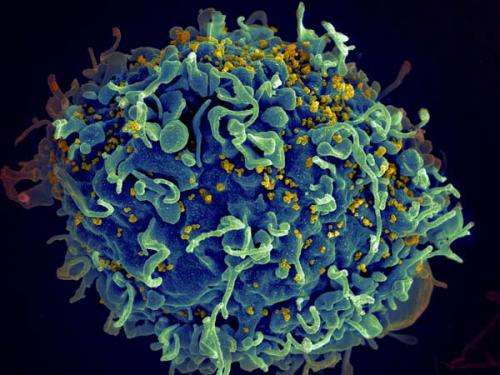Study finds limited mutations involved in transmission of drug-resistant HIV

In the largest study of its kind to date, researchers at Stanford University School of Medicine and their colleagues have found that worldwide only a limited number of mutations are responsible for most cases of transmission of drug-resistant HIV.
HIV, the virus that causes AIDS, can mutate in the presence of antiviral drugs, and these mutations can be transmitted from one person to the next.
In the new study of more than 50,000 patients in 111 countries, the researchers found a small group of mutations accounted for a majority of the cases of transmission-related resistance to the HIV drugs used to treat infections in resource-limited settings. The results suggest the levels of transmission of drug-resistant strains have not increased globally as much as once feared, said Robert Shafer, MD, professor of medicine at Stanford and principal investigator for the study.
"What we are showing is that the rates of transmitted drug-resistant HIV in the low- and middle-income countries most affected by HIV have increased modestly. The rate of increase in sub-Saharan Africa has been low, and an increase has not been detected in south Asia and Southeast Asia. That's good news," Shafer said.
However, there continues to be an increase in drug resistance because the regimens used by HIV patients in lower-income countries are often not as robust as those used in upper-income countries, and strict adherence to a daily, lifetime regimen of taking the pills is challenging, particularly for people in the poorest parts of the world, he noted.
"It is inevitable that transmitted drug resistance will increase further, so we need to continue ongoing monitoring to ensure successful, long-term treatment outcomes for the millions of people on therapy worldwide," Shafer said.
He said the findings could have important implications for treatment in these hard-hit regions, leading to the possible development of an inexpensive test for key mutations to help determine which drugs should be given to previously untreated patients.
The study will be published online April 7 in PLOS Medicine.
Halting the spread of HIV
Since 2003, the international community has made major strides toward the goal of universal antiretroviral treatment for HIV, with 11.7 million people in low- and middle-income countries now receiving the lifesaving therapy, according to the Joint United Nations Programme on HIV/AIDS. But there has been concern that, with wider availability of these medications, drug resistance could spread and rapidly reverse those gains.
To gauge the extent of the problem, Shafer and his colleagues reviewed HIV sequencing data on 50,870 individuals across the globe, taken from 287 studies published between 2000 and 2013. Nearly 60 medical institutions on five continents contributed data for the study. The researchers analyzed each virus sequence for the presence of 93 mutations previously shown to be indicators of drug resistance.
They found the overall prevalence of transmitted drug resistance ranged from 2.8 percent in sub-Saharan Africa to 11.5 percent in North America. In south Asia and Southeast Asia, the prevalence of transmitted resistance remained unchanged during the decade of expansion in drug treatment. However, many studies from sub-Saharan Africa have shown the prevalence of resistance to be more than 5 percent in recent years, Shafer noted. He said the inevitable increase in transmitted drug resistance could undermine confidence in the ability to treat HIV in low-income regions and potentially dissuade new patients from seeking care.
To avoid that prospect, the study points to the possibility of creating a simple, inexpensive test for the key resistance-related mutations, which could help clinicians pinpoint the drugs likely to be most effective for individual patients. In both Africa and Asia, the researchers identified four specific resistance-related mutations that were associated with the drugs nevirapine and efavirenz. These are among an older, less-expensive class of drugs known as non-nucleoside reverse transcriptase inhibitors, typically used in the developing world as part of a standard, daily regimen.
"The idea of an inexpensive test for key mutations is attractive because if it were used in conjunction with a viral load test [a measure of the amount of virus in a patient's blood], it would allow physicians to know if therapy should be changed and where adherence counseling should be given," Shafer said. Patients who show signs of these mutations could be switched to newer, albeit more costly, drugs known as protease inhibitors, which are less susceptible to resistance, he said.
"You could therefore shut off the flow of drug resistance by using regimens that are less vulnerable to the development of drug resistance in the first place," he said.
Unrelated strains
The study also found that the drug-resistant strains did not come from a single line of resistant viruses, but were distinctly different from each other, suggesting they had been acquired independently and not as a result of a single transmission chain. That contrasts with patterns of resistance in other microbes, such as malaria and tuberculosis, where resistant strains tend to move rapidly among populations, Shafer said. It also contrasts with an emerging pattern of drug resistance in many upper-income countries, where 20 years of HIV therapy have spawned the spread of many highly drug-resistant strains.
"We are finding that the strains being detected in low-income countries are pretty much unrelated to one another. So that suggests these have not yet gained a foothold in the population, and are less often being transmitted among people who have never received the drugs before," Shafer said.
More information: Rhee S-Y, Blanco JL, Jordan MR, Taylor J, Lemey P, Varghese V, et al. (2015) Geographic and Temporal Trends in the Molecular Epidemiology and Genetic Mechanisms of Transmitted HIV-1 Drug Resistance: An Individual-Patient- and SequenceLevel Meta-Analysis. PLoS Med 12(4): e1001810. DOI: 10.1371/journal.pmed.1001810
















